Polish cuisine (Polish: kuchnia polska) is a style of cooking and food preparation originating in or widely popular in Poland. Due to Poland's history, Polish cuisine has evolved over the centuries to be very eclectic, and it shares many similarities with other regional cuisines. Polish-styled cooking in other cultures is often referred to as à la polonaise.
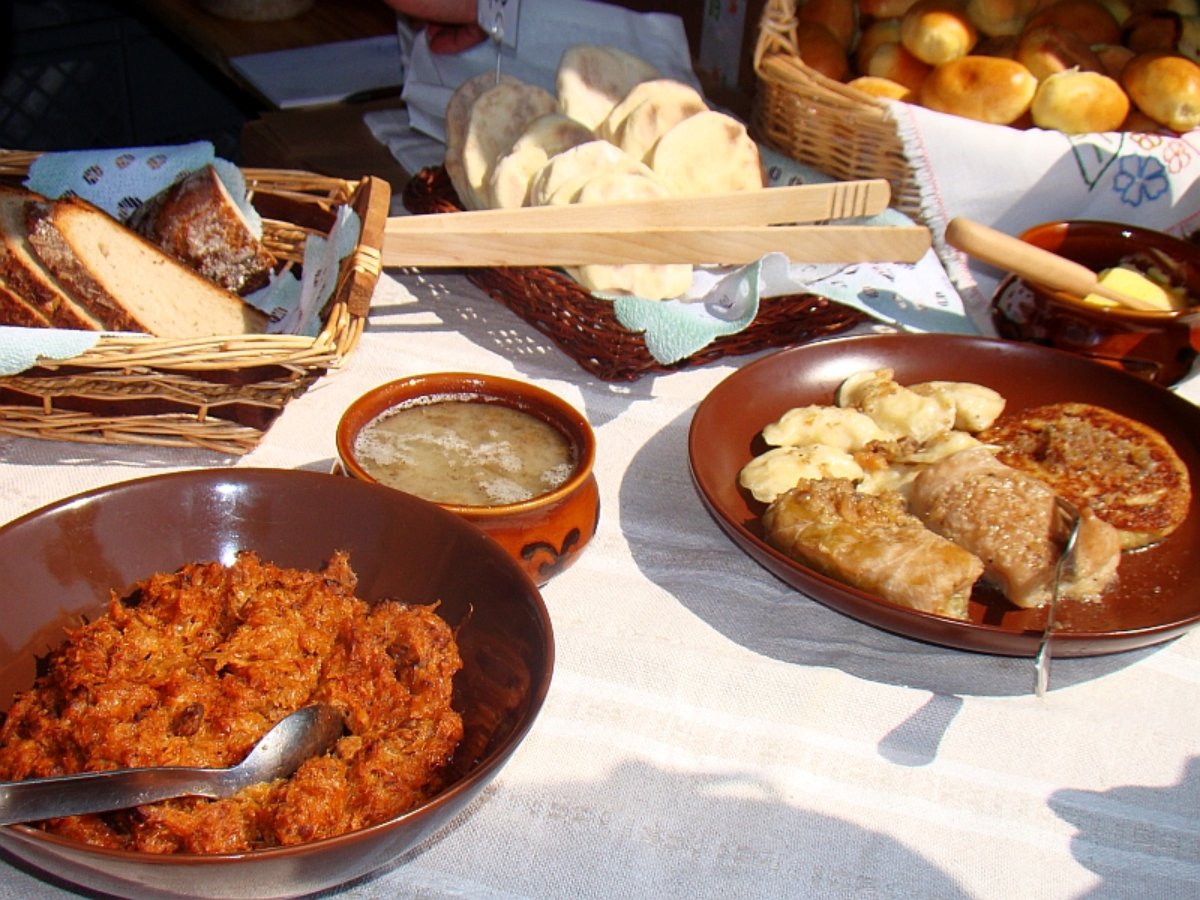
Polish cuisine shares many similarities with other Slavic countries, especially Czech, Slovak, Belarusian, Ukrainian and Russian cuisines. It has also been widely influenced by other Central European cuisines, namely German, Austrian and Hungarian cuisines as well as Jewish, French, Turkish and Italian culinary traditions.It is rich in meat, especially pork, chicken and beef (depending on the region), winter vegetables (cabbage in the dish bigos), and herbs. It is also characteristic in its use of various kinds of noodles the most notable of which are kluski as well as cereals such as kasha (from the Polish word kasza). Generally speaking, Polish cuisine is hearty and uses a lot of cream and eggs.
The traditional dishes are often demanding in preparation. Many Poles allow themselves a generous amount of time to serve and enjoy their festive meals, especially Christmas eve dinner (Wigilia) or Easter breakfast which could take a number of days to prepare in their entirety.
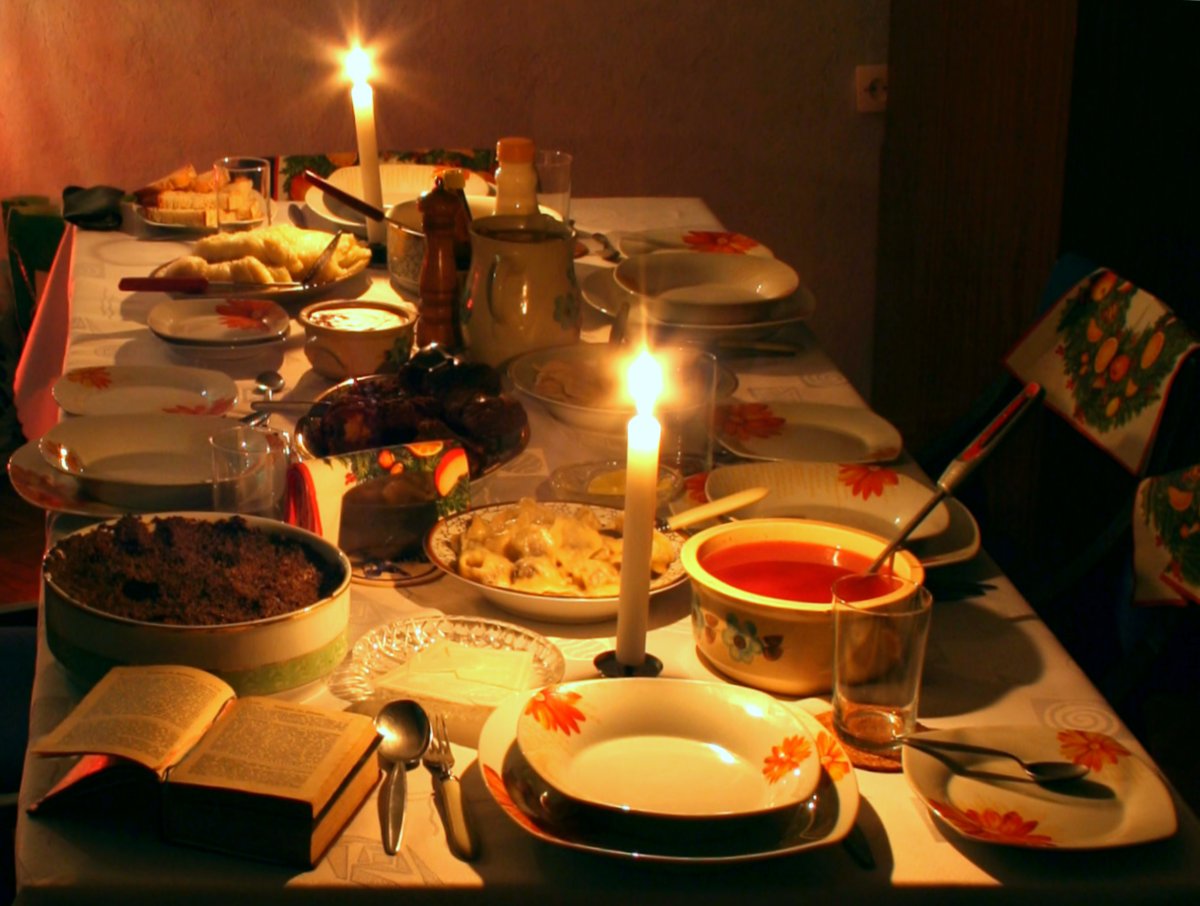
The Polish national dishes are bigos [ˈbiɡɔs]; pierogi [pʲɛˈrɔɡʲi]; kiełbasa; kotlet schabowy [ˈkɔtlɛt sxaˈbɔvɨ] (type of breaded cutlet); gołąbki [ɡɔˈwɔ̃pkʲi] (type of cabbage roll); zrazy [ˈzrazɨ] (type of roulade); roast (Polish: pieczeń) [ˈpʲɛt͡ʂɛɲ]; sour cucumber soup (Polish: zupa ogórkowa) Polish pronunciation: [ˈzupa ɔɡurˈkɔva]; mushroom soup, (Polish: zupa grzybowa) [ˈzupa ɡʐɨˈbɔva] (quite different from the North American cream of mushroom); tomato soup (Polish: zupa pomidorowa) [ˈzupa pɔmidɔˈrɔva];[7] rosół [ˈrɔsuw] (variety of meat broth); żurek [ˈʐurɛk] (sour rye soup); flaki [ˈflakʲi] (variety of tripe soup); and barszcz [barʂt͡ʂ] among others.[8]
Bigos
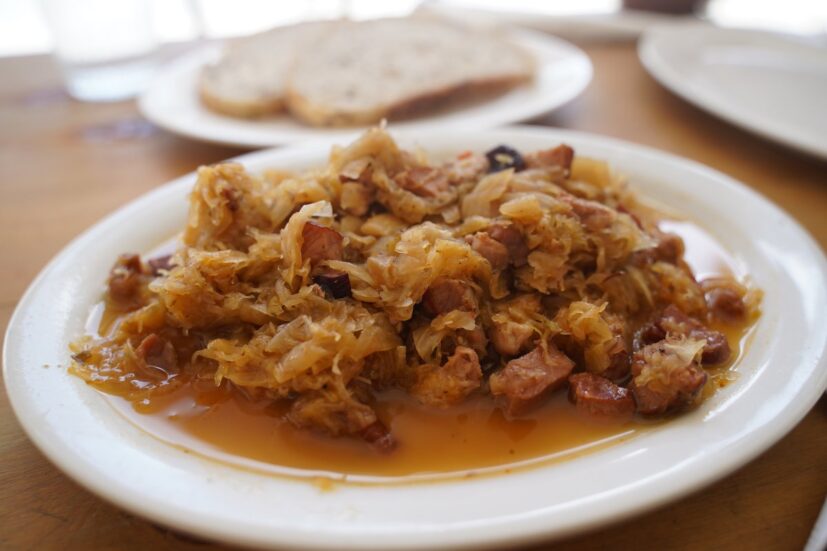
[known as a hunter's stew], is a traditional meat and cabbage stew is a Polish national dish. Typical ingredients include white cabbage, sauerkraut (kapusta kiszona in Polish), various cuts of meat and sausages, often whole or puréed tomatoes, honey and mushrooms. In very rare cases bigos can be made without meat or unpreserved cabbage, but the presence of sauerkraut is absolutely essential. The meats may include pork (often smoked), ham, bacon, sausage, veal, beef, and, as bigos is considered a hunter's stew, venison, rabbit, or other game; leftover cuts find their way into the pot as well. It may be seasoned with pepper, caraway, juniper berries, bay leaf, marjoram, pimenta, dried or smoked plums, often red wine and other ingredients.
Bigos is usually served with mashed potatoes or rye bread
Pierogi
are filled dumplings of East European origin. They are made by wrapping pockets of unleavened dough around a savory or sweet filling and cooking them in boiling water. These dumplings are popular in Slavic (Polish, Slovak, Ukrainian), Baltic (Latvian, Lithuanian) and other Eastern European cuisines (such as Romanian) where they are known under local names. Pierogi and varenyky are especially associated with Poland, Ukraine, Slovakia and Canada where they are considered national dishes.
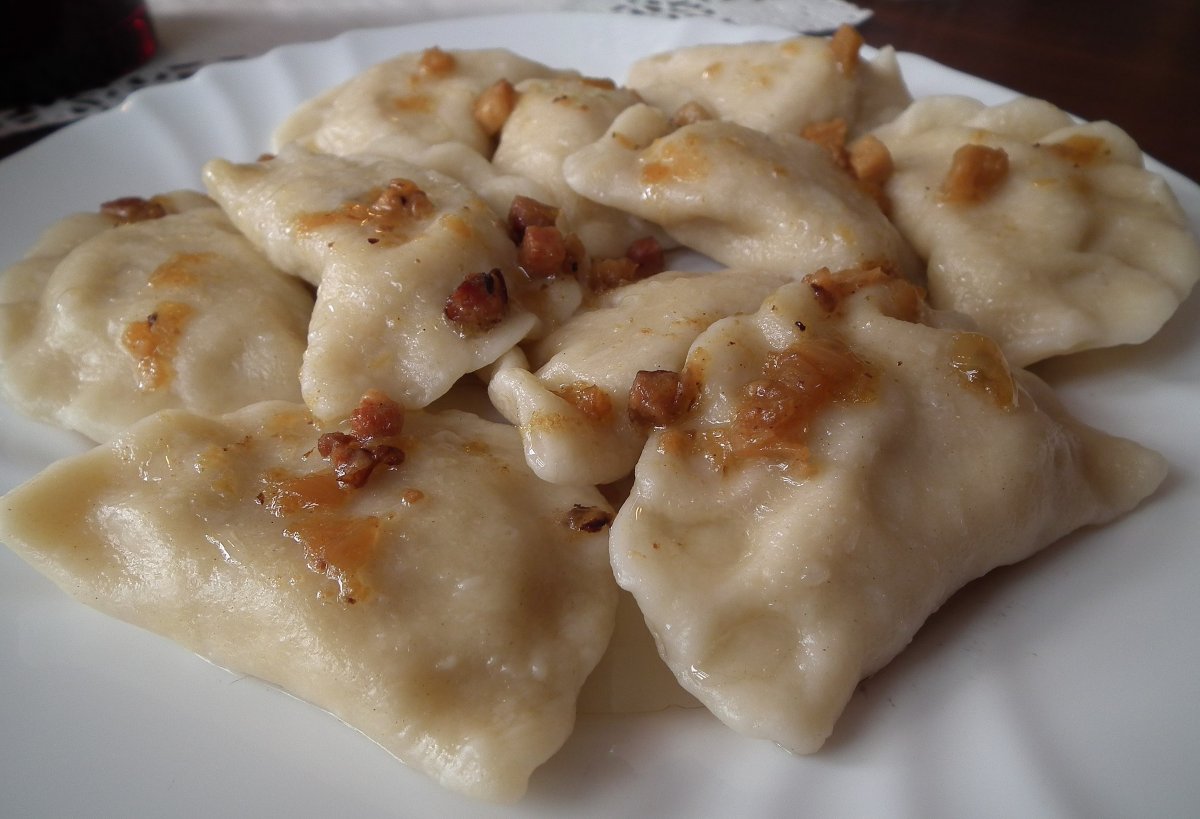
Pierogi are often semi-circular but triangular and rectangular ones are also found. Typical fillings include potato, sauerkraut, ground meat, cheese and fruits. The dumplings may be served with toppings, such as melted butter, sour cream or fried onion. The traditional savory method is with onion, and sweet method with sour cream.
Pickled cucumber
typical Polish pickled cucumber is a cucumber that has been pickled in a brine.
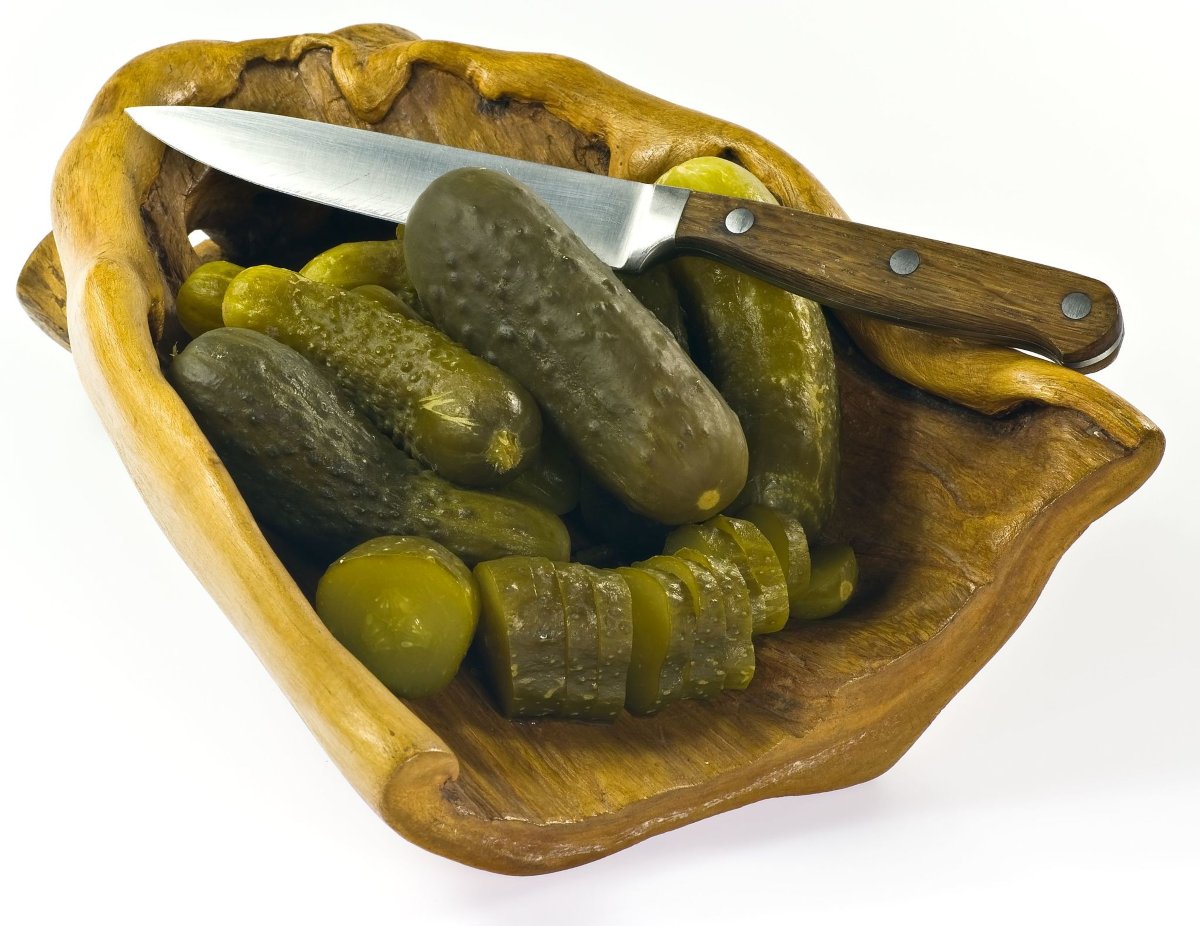
The Polish-style pickled cucumber is a variety developed in the northern parts of Europe. It has been exported worldwide and is found in the cuisines of many countries. It is sour, similar to kosher dills, but tends to be seasoned differently.[citation needed] It is usually preserved in wooden barrels. A cucumber only pickled for a few days is different in taste (less sour) than one pickled for a longer time and is called ogórek małosolny, which literally means 'low-salt cucumber'. This distinction is similar to the one between half- and full-sour types of kosher dills (see above).
Żurek
The sour rye soup is a soup made of soured rye flour and meat (usually boiled pork sausage or pieces of smoked sausage, bacon or ham). It is specific to the cuisines of Poland and Belarus, where it is known as żur or żurek A variant made with wheat flour instead of rye is known in Poland as barszcz biały ("white borscht"). Varieties of this soup are also found in the cuisines of other western Slavic nations such as Slovakia (kyslóvka) and Czech Republic (kyselo - with mushrooms and without meat) In Poland it is sometimes served in an edible bowl made of bread or with boiled potatoes. The recipe varies from region to region.
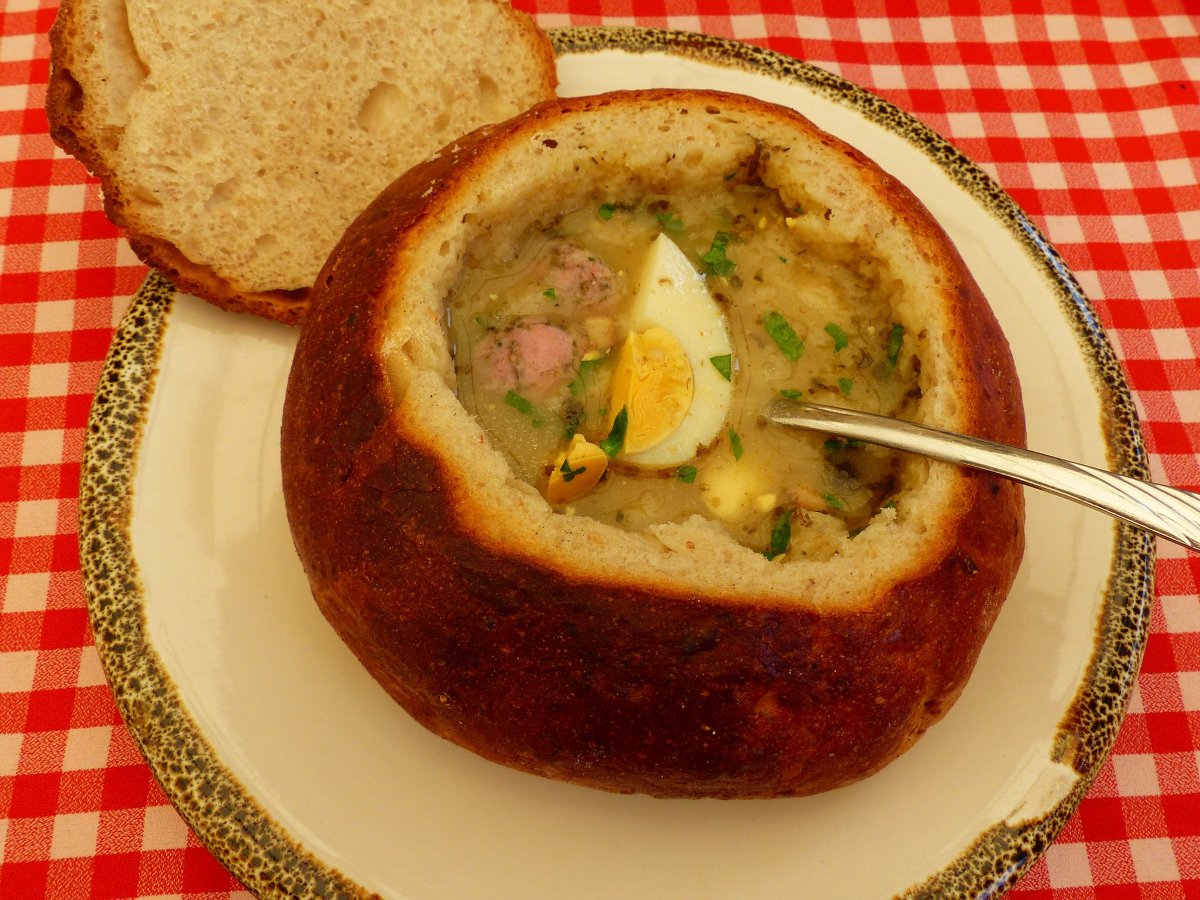
In Silesia, a type of sour rye soup known as żur śląski is served in a bowl, poured over mashed potatoes. In the Podlaskie region, it is common to eat żurek with halved hard-boiled eggs.
In Poland żurek is traditionally eaten at Easter, but is also popular during other parts of the year. It is sometimes flavored with bits of sausage, usually eaten with bread or buns, or even served in a bowl made from bread.
Oscypek
is a smoked cheese made of salted sheep milk exclusively in the Tatra Mountains region of Poland. Oscypek is made using salted sheep's milk, with the addition of cow's milk strictly regulated by the protected recipe. Unpasteurized salted sheep's milk is first turned into cottage cheese, which is then repeatedly rinsed with boiling water and squeezed. After this, the mass is pressed into wooden, spindle-shaped forms in decorative shapes. The forms are then placed in a brine-filled barrel for a night or two, after which they are placed close to the roof in a special wooden hut and cured in hot smoke for up to 14 days.
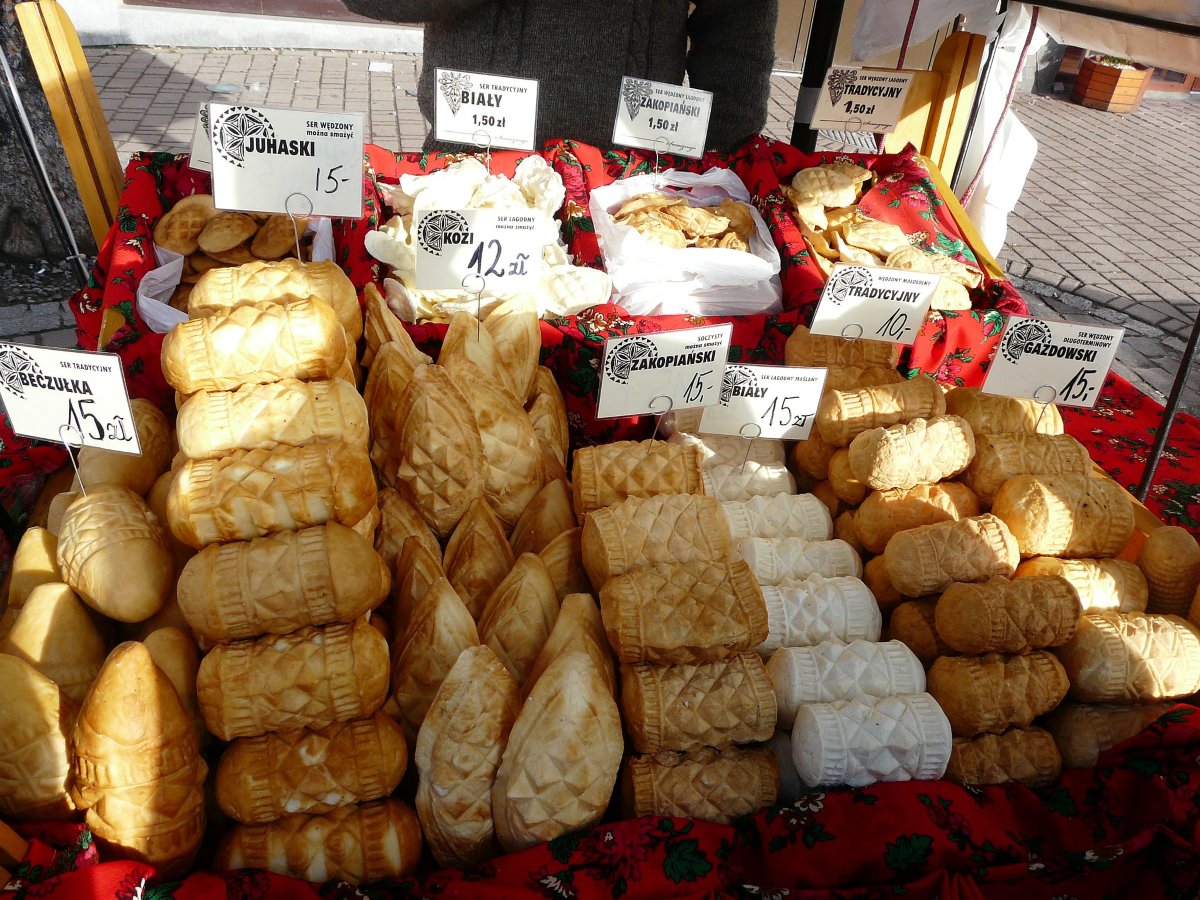
Sausage
is a staple of Polish cuisine and comes in dozens of varieties, smoked or fresh, made with pork, beef, turkey, lamb, chicken or veal with every region having its own speciality. Of these, the Kiełbasa Lisiecka, produced in Małopolskie,has, since late 2010 had PGI protection. There are official Polish government guides and classifications of sausages based on size, meat, ready-to-eat or uncooked varieties.

Originally made at home in rural areas,there are a wide variety of recipes for kielbasa preparation at home and for holidays.[10] Kielbasa is also one of the most traditional foods served at Polish weddings.Popular varieties include:
- kabanosy, a thin, air-dried sausage flavoured with caraway seed, originally made of pork
- kiełbasa wędzona, polish smoked sausage, used often in soups.
- kiełbasa krakowska, a thick, straight sausage hot-smoked with pepper and garlic; its name comes from Kraków
- kiełbasa wiejska ([ˈvʲejska]), farmhouse sausage; it is a large U-shaped pork and veal sausage with marjoram and garlic; its name means "rural" or (an adjectival use of) "country", or (adjectival use of) "village".
- kiełbasa weselna, "wedding" sausage, medium thick, u-shaped smoked sausage; often eaten during parties, but not exclusively
- kaszanka or kiszka is a traditional blood sausage
- myśliwska is a smoked, dried pork sausage.
- kiełbasa biała [disputed – discuss] a white sausage sold uncooked and often used in soups.
The most popular kiełbasa is also called "Kiełbasa Polska" ("Polish Sausage") or "Kiełbasa Starowiejska" ("Old Countryside Sausage"). This one comes closest to what is generally known in America as "kiełbasa" (a Polish sausage). Nowadays, many major meat packers across America offer a product called "kiełbasa," usually somewhat different from the original.
In Poland, kiełbasa is often served garnished with fried onions, and – in the form of cut pieces – smoked kiełbasa can be served cold, hot, boiled, baked or grilled. It can be cooked in soups such as żurek (sour rye soup), kapuśniak (cabbage soup), or grochówka (pea soup), baked or cooked with sauerkraut, or added to bean dishes, stews (notably bigos, a Polish national dish), and casseroles. Kiełbasa is also very popular served cold as cold cuts on a platter, usually for an appetiser at traditional Polish parties. It is also a common snack (zagrycha) served with beer or plain vodka.
A less widely encountered but equally popular variety of kiełbasa is the White Fresh (biała - i.e. "white"). It is mainly used as a soup meat, and is therefore sold uncooked and unsmoked. When used, it is prepared by boiling, frying or boiling in soup in place of raw meat. This kiełbasa's taste is similar to a white Thuringian sausage. Traditionally served with barszcz biały.
Kotlet schabowy
is a Polish variety of pork breaded cutlet coated with breadcrumbs similar to Viennese schnitzel,[1] but made of pork tenderloin (with the bone or without), or with pork chop. There's also the Polish variety of the chicken breast cutlet coated with breadcrumbs looking somewhat similar, or the turkey cutlet coated with breadcrumbs (kotlet z indyka [ˈkɔtlɛt z inˈdɨka]) made the same way.
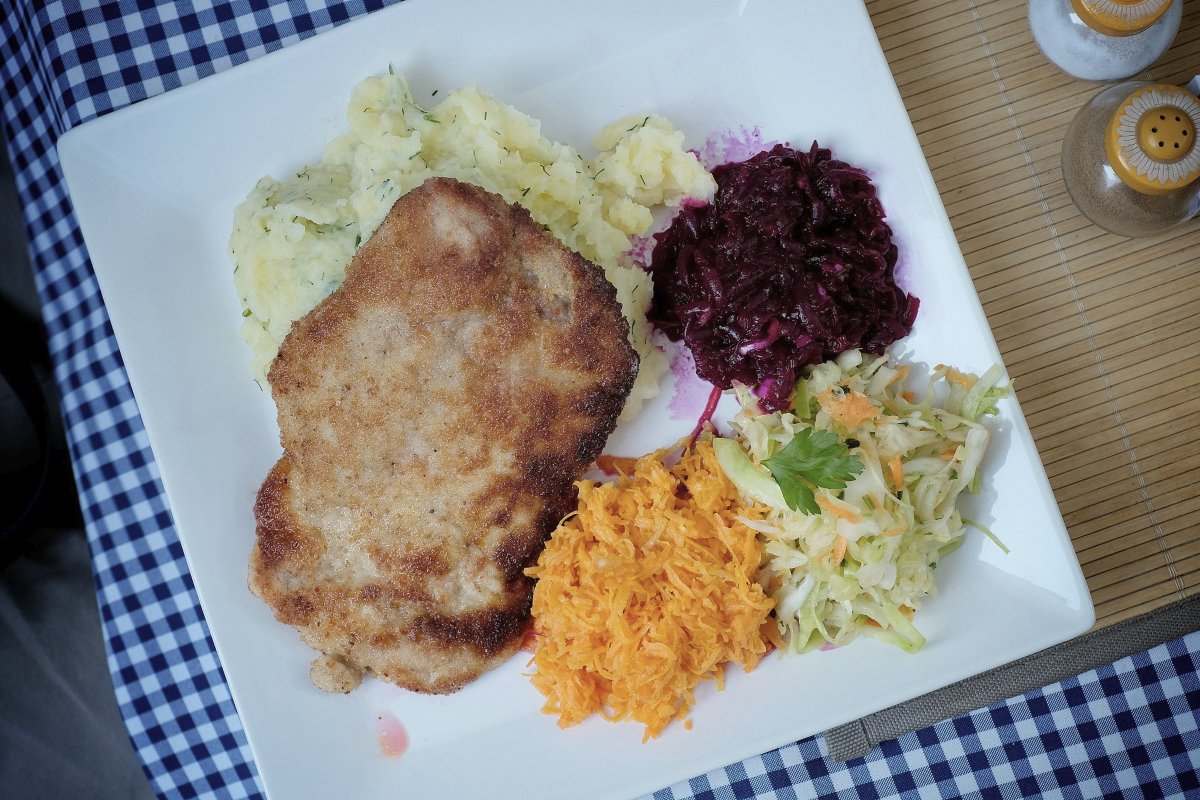
Pork tenderloin is cut into 1 inch slices and pounded with mallet until it becomes thinner and soft. Eggs and spices are combined on a separate plate and lightly beaten. The meat is dipped in flour, then in egg, and then covered in breadcrumbs. The oil is heated in a frying pan till it starts to sizzle and the meat is placed onto it, then turned over a couple of times. Served hot. Kotlet schabowy can be served with cooked potatoes, mashed potatoes, fried mushrooms, cooked vegetables (seared cabbage), with salads or with coleslaw.
Gołąbki
is a cabbage roll common in Polish cuisine made from lightly soft-boiled cabbage leaves wrapped around minced pork or beef, chopped onions, and rice or barley, which are baked in a casserole dish and are usually served with a creamy tomato sauce. Gołąbki is the plural of gołąbek, the diminutive of gołąb, meaning "pigeon", referring to the fist-sized or smaller roll's shape.
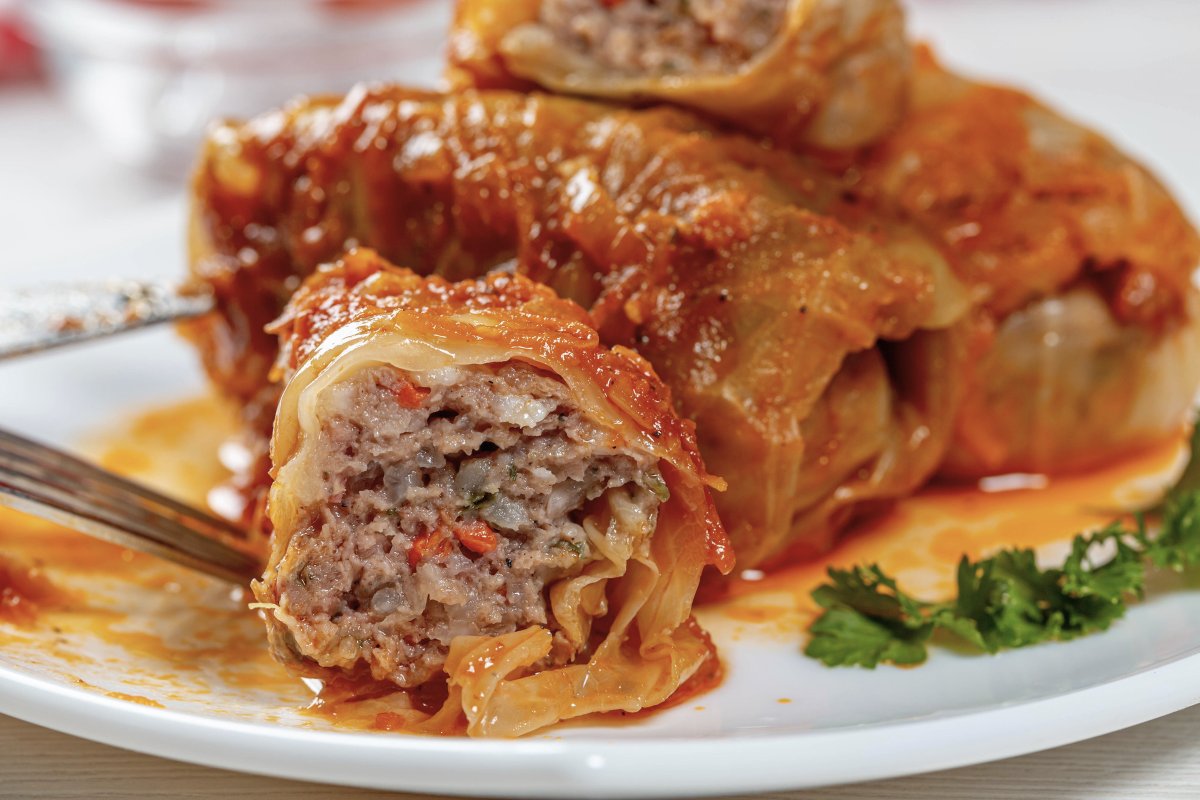
Zrazy
(Polish: zrazy, is a meat roulade dish popular in Eastern Europe, especially Poland (Silesian rouladen). Classic zrazy have a rolled shape and are made of thin slices of beef, which is flavored with salt and pepper and stuffed with vegetables, mushrooms, eggs, and potato. However, there are numerous stuffing combinations as new ones are encouraged, such as pickles and bacon. The stuffed meat is then rolled and secured with thread or toothpicks. After being fried in oil for a short period of time, the zrazy are placed in a casserole with celery, onion, and various spices and covered with a hot stock. The casserole is then stewed at a low temperature.
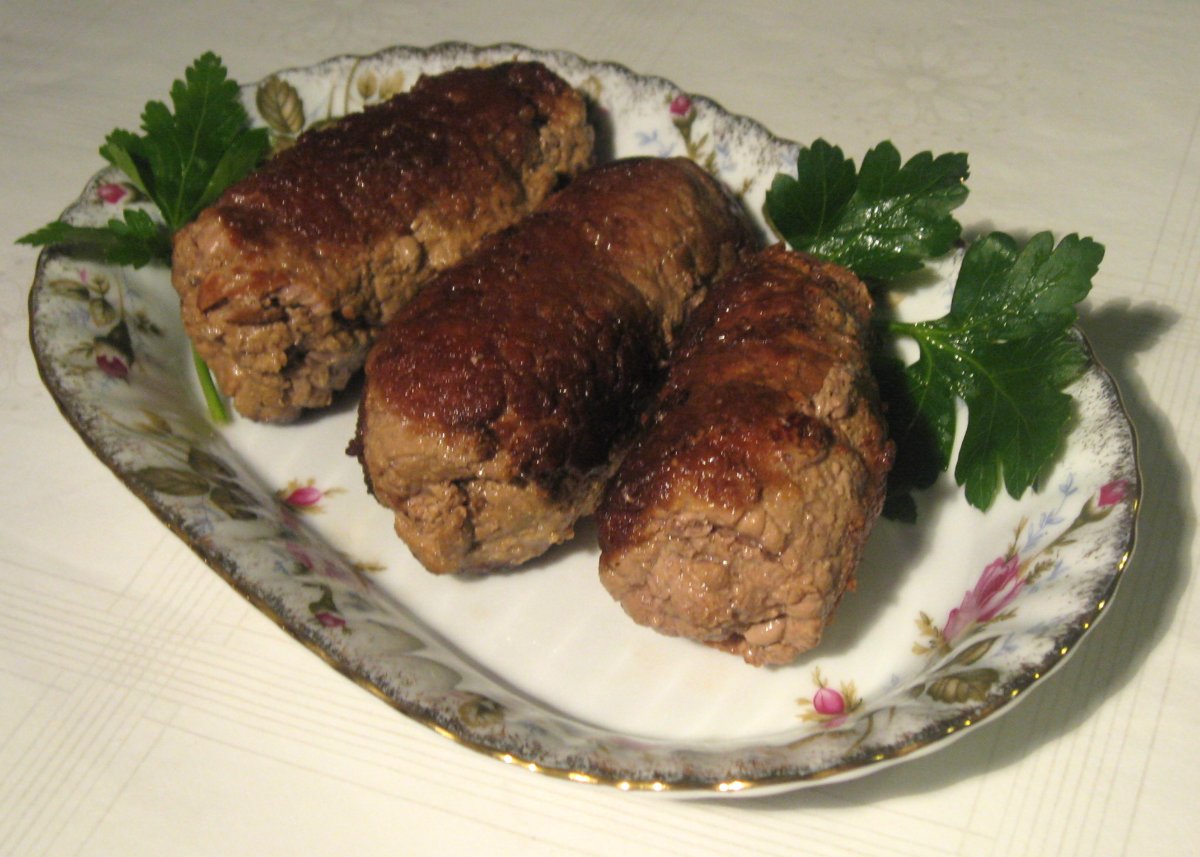
Prior to serving, the threads or toothpicks are removed; the zrazy is then drained and sometimes dusted with flour or topped with sour cream. Zrazy are eaten with the sauce in which they were stewed and are usually garnished with crumbled kasha, usually buckwheat and barley. In place of beef, zrazy can also be made with veal or pork.
Flaki or flaczki
which is a traditional Polish meat stew. It can be an acquired taste, but is one of the many soups that are an important part of the Polish diet.[4] Its name is derived from its main ingredient: thin, cleaned strips of beef tripe (in Polish: flaki - which can also be literally translated to "guts"). The method of preparation may vary slightly depending on the region. Some common ingredients include beef tripe, beef, bay leaf, parsley, carrot, beef broth, and spices to taste, including salt, black pepper, nutmeg, sweet paprika, and marjoram. Ready-made convenience-type equivalents of the labor-intensive flaczki are available.[6] Sometimes pork tripe can be used instead of the beef tripe especially in the ready-made versions of the dish sold in Poland.
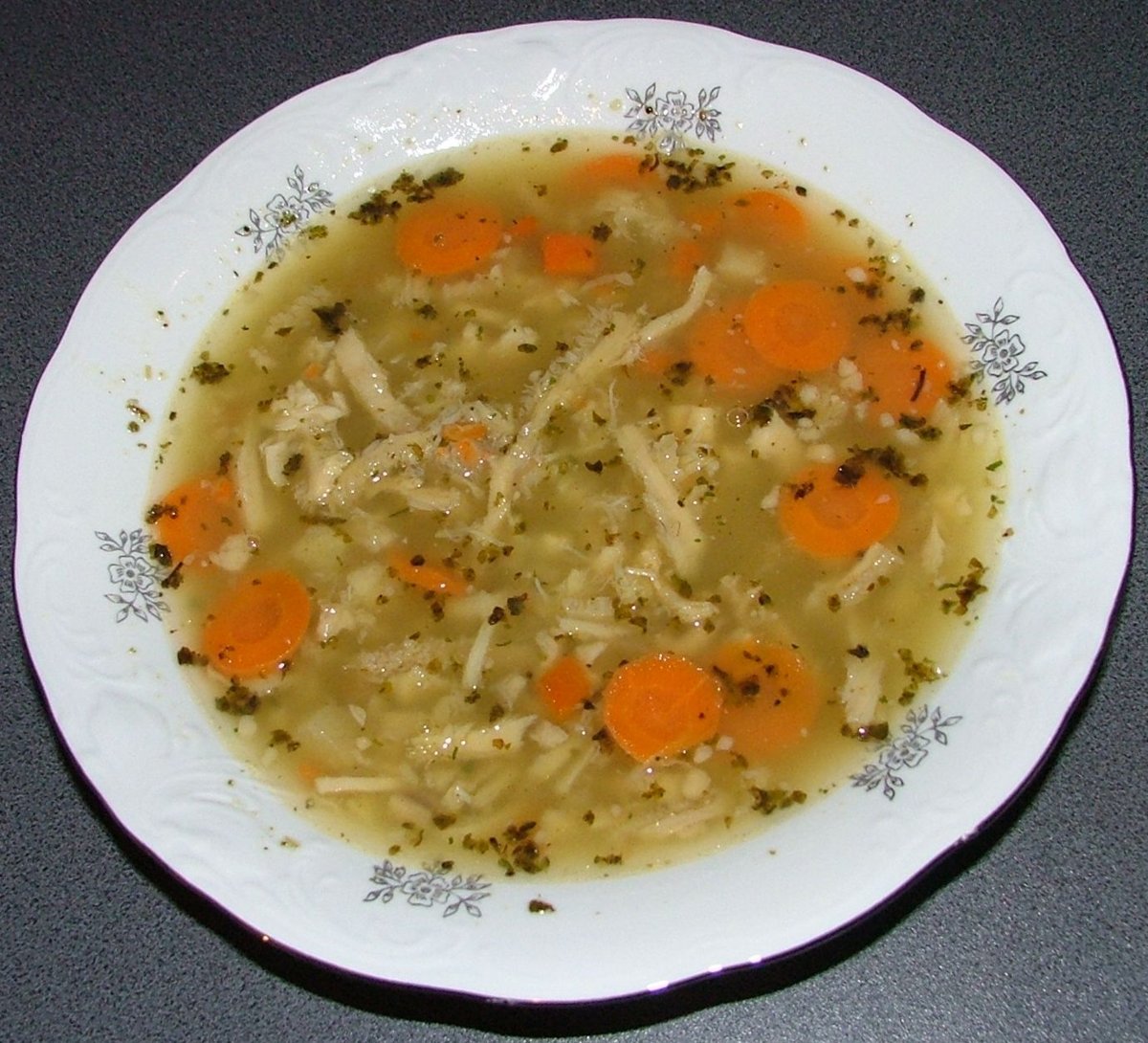
Tomato concentrate is sometimes added to flaki, and some may cook the tripe without a roux. A popular addition to improve the 'nobleness' is the addition of meatballs, which are often found in a regional variant known as 'flaki po warszawsku' (Warsaw-style flaki). Ready-made flaki in cans or jars are widely available in grocery stores throughout Poland which also include "Flaki po Zamojsku" (Zamość-style Flaki). A variant of flaczki, in which fowl stomach is used instead of cow’s, is also known and called ‘flaki drobiowe’ (poultry flaki).
Źródło: wikipedia


